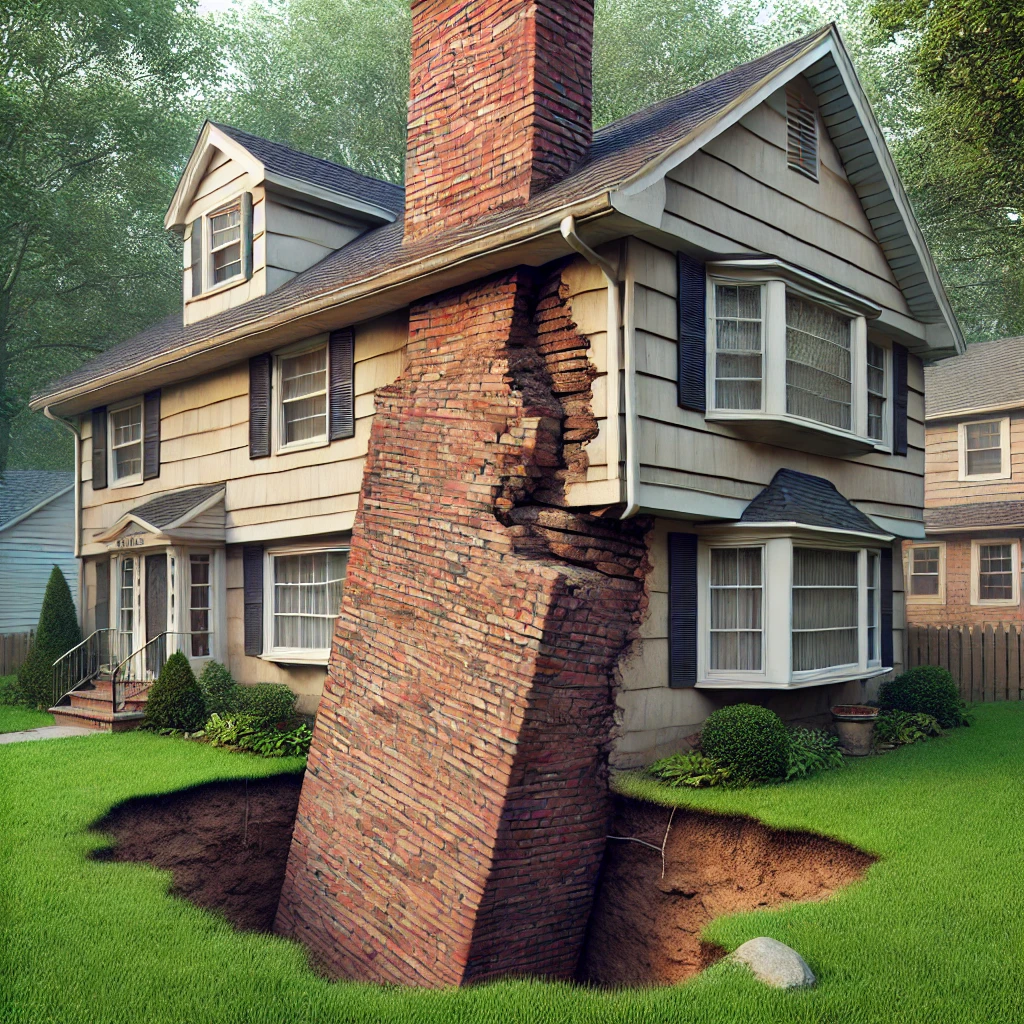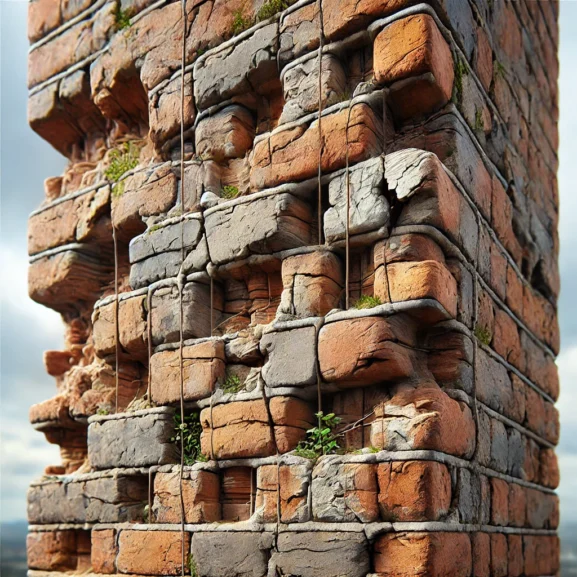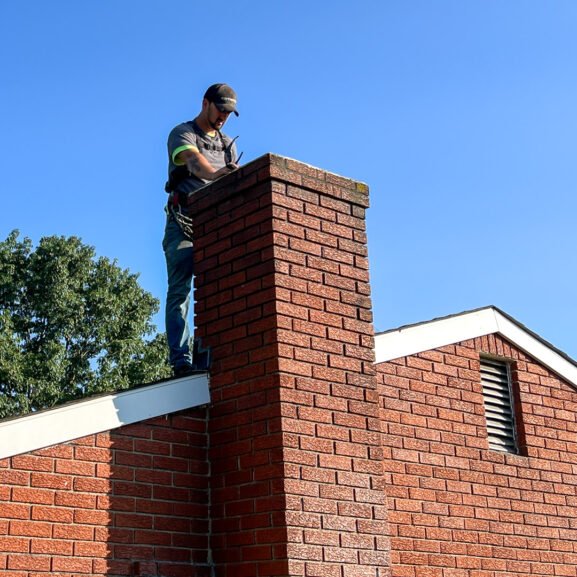Sinking Chimneys Due to Poor Foundation Support: Causes, Risks, and Repair Solutions
Sinking Chimneys Due to Poor Foundation Support: Causes, Risks, and Repair Solutions
We’ve all enjoyed the charm of a cozy fireplace. But what happens when that chimney starts to sink? Sinking chimneys are more than just an eyesore. They show that the foundation support is weak, which can lead to expensive repairs. When the ground under a chimney is unstable, it can make the structure lean or crack. This can create serious safety risks.
In this article, we’ll look at the common causes of sinking chimneys. We’ll focus on how poor foundation support plays a big role. We’ll also talk about the warning signs you should look out for and the solutions to stop further damage. By understanding these issues, we can protect our homes. This will help ensure our chimneys stay safe and strong for years to come.
Chimney Sinking Explained: Symptoms, Causes, and Solutions
Sinking chimneys are more than eyesores; they signal potential foundation issues. Spotting symptoms early helps us avoid costly repairs. Key signs include:
- Visible Tilting: If the chimney leans like the Tower of Pisa, it’s not a sightseeing spot. It shows serious sinking problems.
Cracks in Brickwork: Cracked chimneys usually mean there are issues with the foundation.
Separation from House: Gaps between the chimney and house walls can be a sign that the chimney is shifting.
Weather brings changing temperatures and soil conditions. These can affect chimney stability. Poor foundation and soil erosion cause structural problems.
- Foundation Inspection: Certified professionals assess damage. Regular inspections prevent major issues. Visit National Fire Protection Association for more safety tips.
- Foundation Repairs: Reinforce foundations to stabilize chimney settlement, ensuring chimney safety.
- Professional Support: Avoid DIY; call experts to manage chimney tilting or repair.
Reach out to professionals for consultation. Our team specializes in tackling foundation support for aging homes.
Educating homeowners minimizes hazards and promotes safe, stable chimneys. For further information on fireplace safety, check Chimney Safety Institute of America.
Causes of Poor Foundation Support
Sinking chimneys often arise from poor foundation support. Uncover the main causes to keep your chimney stable.
Inadequate Soil Testing
Skipping soil testing can lead to weak foundations. Without it, we might place chimneys on the wrong type of soil. This can cause sinking problems. The soil can be very different, from sandy shores to clay-heavy areas. Each type of soil needs its own support structure. If the soil and foundation don’t match well, the chimney may tilt. This can cause cracks in the chimney. Soil testing helps create a foundation that stays strong, even if the soil shifts. If you’re concerned about smoke or foundation issues, reach out to professionals for consultation. We’re here to help.
Improper Design and Materials
Design flaws and subpar materials contribute to structural problems. A misdesigned foundation doesn’t distribute weight effectively, causing sinking chimneys. Using incorrect or weak materials aggravates the problem, destabilizing the structure. On the other hand, quality materials and expert design ensure long-lasting stability. Craving more fireplace safety tips? Check Fireplace Safety Council Fireplace Safety Organization for guidance or contact us directly.
Water Damage and Erosion
Water damage weakens foundation support, and the precipitation levels are no joke. Water seeps into the foundation, causing erosion and shifting chimneys. A proper drainage system safeguards the foundation from moisture and prevents potential repairs. Keeping water at bay prolongs chimney safety. Regularly checking and maintaining proper drainage helps avoid future erosion. Stay ahead of the storm with proactive measures and consult experts like us for routine inspections. Don’t forget to check out the Chimney Safety Institute of America Chimney Safety Institute for their information.
Signs of a Sinking Chimney

Sinking chimneys are more than just an eyesore. Their presence signals deeper foundation issues that could lead to costly repairs. Spotting these signs early ensures chimney safety and stability.
Visible Cracks and Gaps
Cracked chimney bricks, anyone? Seeing gaps in the bricks or mortar isn’t just a quirky home feature. It’s a direct indicator of chimney settlement and poor foundation support. Climatic conditions can make these gaps larger over time. Look closely for cracks forming between the chimney and your house. These telltale signs mean it’s time to consult experts. Let’s avoid that game of “will it fall or won’t it?” Reach out to professionals for consultation.
Tilting or Leaning Chimney Structure
A leaning chimney might make you think of a famous tower. But we don’t want your house to become a tourist spot. Tilting indicates serious structural problems and shifting chimneys due to poor foundation. It’s a signal that intervention is needed immediately. Rather than risking it, get a foundation inspection to solidify your home’s stability. Visit the Chimney Safety Institute of America or NFPA for more on chimney safety.
Remember, leaning towers may be famous, but chimneys? Not so much. Let’s keep them straight and safe.
Dangers of Ignoring a Sinking Chimney
A sinking chimney is more than just an eyesore. It’s a problem that needs quick action. If you leave it unchecked, it can cause expensive repairs. It could also put your home at risk.
Structural Damage to Home
A sinking chimney can cause major damage to your home. Foundation problems don’t happen alone. They usually come with other structural issues too.
- Cracked Walls: Shifting chimneys cause cracks in drywall and plaster.
- Ceiling Damage: Misaligned chimneys stress ceilings, leading to unsightly stains or splits.
- Roof Trouble: Gaps and leaks can form around sinking chimneys. These gaps let rain in. This can cause water damage over time.
Homes, with soil conditions resembling a wacky sponge, are especially vulnerable. Regular inspections are crucial here. Reach out to professionals for consultation.
National Fire Protection Association (NFPA) provides more fireplace safety tips.
Safety Hazards
Ignoring a sinking chimney poses serious risks. Your chimney’s stability is directly tied to your home’s safety.
- Blockages: Misaligned chimneys lead to obstructions, causing smoke to re-enter.
- Carbon Monoxide: A stable chimney vents gases like carbon monoxide safely. A faulty one can lead to poisoning.
- Fire Risk: Cracks foster chimney fires by allowing heat and embers to escape.
Foundation repairs ensure chimney tilting doesn’t jeopardize family safety. We recommend professional help—skip the DIYs. Book a consultation and keep your home safe!
For further chimney safety information, visit the Chimney Safety Institute of America.
Repair Solutions for Sinking Chimneys

Sinking chimneys can really throw a wrench in home safety and appearance. They might look like they’re just trying to shake hands with the ground, but it’s no laughing matter. Let’s explore some repair solutions.
Foundation Reinforcement Techniques
Let’s jump into some techniques for giving chimneys a sturdy foundation hug:
- Helical Piers: These are metal anchors that go deep into the ground for strong support. They lift chimneys that are sinking. They stabilize them by shifting the weight to more stable soil layers.
Underpinning: This method adds more depth to the foundation. We dig below the current footing and fill it with concrete. This strengthens the foundation and stops it from shifting again.
Grout Injection: We inject grout under your foundation. This helps fill any empty spaces. It also makes your foundation more stable. This method works well for fixing small settlement problems.
These methods require professional expertise. DIY might save a buck, but a professional call saves the day. Reach out to professionals for consultation. For more on chimney safety, check out the NFPA.
Professional Assessment and Repair
Before starting repairs, it’s important to have a professional assessment. Think of it like a check-up for your chimney, just like you would visit a doctor.
- Inspection: Certified inspectors check your chimney for problems. They look for signs like cracks or tilting. They help find the cause of the issues. Then, they plan the right repairs.
- Specialized Solutions: Once the inspection is complete, experts recommend tailored repair solutions. These could include replacing damaged bricks or reinforcing the chimney’s structure.
- Waterproofing: It’s not just sunscreen for humans; chimneys need protection too. Waterproofing prevents water damage, which can worsen sinking problems.
Complexities in the soil call for these expert evaluations. Visit Chimney Safety Institute of America for detailed safety info. Remember, a stable chimney isn’t just a pipe dream—it’s crucial.
Preventive Measures
Sinking chimneys can be a big hassle. They’re not just ugly, but also tricky to fix. Don’t worry, though. We can prevent these issues. The key is smart maintenance and design from the beginning.
Regular Inspections and Maintenance
Regular inspections keep chimneys in top shape, preventing surprises. Certified professionals can spot early signs of a sinking chimney or foundation issues. A small crack today beats a tilted, cracked chimney tomorrow!
- Annual Inspections: Varying weather demands yearly checks.
- Chimney Cleaning: Remove soot and debris to prevent blockages and fire hazards.
- Prompt Repairs: Address small issues quickly to avoid escalation.
For more details on chimney safety, visit Chimney Safety Institute of America.
Proper Design and Construction Practices
Preventing sinking problems starts with a solid design. Proper foundation support during construction aids in long-term chimney stability.
- Soil Testing: Thorough tests prevent future chimney settlement.
- Quality Materials: Use durable materials for lasting foundation support.
- Experienced Builders: Certified professionals ensure chimneys don’t end up shifting chimneys!
Explore guidelines at the National Fire Protection Association (NFPA).
Got questions about chimney safety? Reach out to professionals for consultation. Remember, while DIYs sound tempting, trusting the pros is always a safer bet.
Conclusion
It’s important to address sinking chimneys to keep our homes safe. Fixing the issue early can save us from expensive repairs. Understanding what causes sinking can help us take action. Spotting the warning signs early is key. If we notice issues early, we can prevent things from getting worse. Regular inspections are important for chimney safety. We should also get expert advice to keep our chimneys stable. Let’s focus on the health of our home’s foundation. It’s important to rely on professionals for the right solutions. With proper care, we can protect our homes from foundation problems. This way, we can feel confident knowing our chimneys are secure..
Frequently Asked Questions
What are the main causes of a sinking chimney?
Sinking chimneys happen mainly due to weak foundation support. Other causes include poor soil testing, bad design, low-quality materials, and water damage. In places with changing weather, soil conditions can be a problem. Erosion can make these issues worse.
What signs indicate a sinking chimney?
If your chimney is sinking, you might notice it tilting. You may also see cracks in the brickwork. The chimney might separate from the house. Other warning signs include damage to the structure. You may notice cracked walls, ceiling problems, or roof leaks.
Why is it dangerous to ignore a sinking chimney?
If you ignore a sinking chimney, it can cause serious problems. It can lead to structural damage and costly repairs. There could also be blockages, carbon monoxide poisoning, and a higher risk of fire. These issues can put your home’s safety at risk if not fixed right away.
How can I prevent my chimney from sinking?
Prevention starts with regular inspections. It also includes proper design and construction practices. Using quality materials is essential. Experienced builders are key to success. Regular maintenance, like chimney cleaning, is important. Timely repairs can fix small issues before they become big problems.
Should I attempt to repair a sinking chimney myself?
DIY repairs for sinking chimneys are not a good idea. You need a professional to assess the situation. They can diagnose the problem accurately. They will also suggest the best solutions. This may include reinforcement and waterproofing strategies.
What are some professional repair solutions for sinking chimneys?
Repair solutions may include techniques like helical piers, underpinning, and grout injection. These methods require professional expertise to ensure effective stabilization and long-term chimney safety.
Can climate affect my chimney’s stability?
Yes, climates with changing weather, can affect your chimney’s stability. Rain and snow can cause moisture buildup. This can lead to erosion of the foundation and water damage. Proper drainage systems are crucial to prevent these issues.
How often should I have my chimney and foundation inspected?
We recommend having annual inspections by certified professionals. Regular checks help spot potential problems early. This allows for quick fixes to keep your structure safe and strong.
Where can I find more information on chimney safety?
For more help with chimney safety, you can check out resources like the Chimney Safety Institute of America. You can also visit the National Fire Protection Association (NFPA) for more information. You can also contact local experts for a free consultation.
How important is soil testing before chimney construction?
Soil testing is important for finding the right foundation. Skipping this step can cause problems. The foundation may not be strong enough. This can lead to sinking and safety issues over time.


